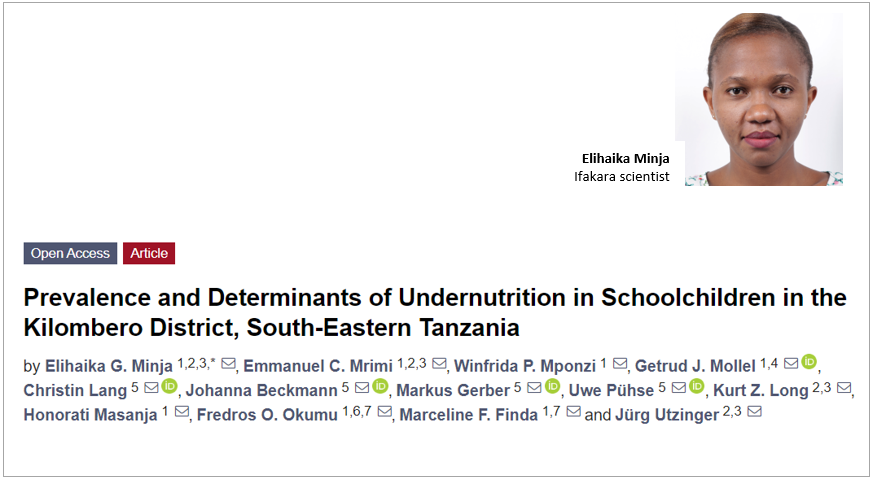
HEALTHY LIFE: Addressing undernutrition risk factors among schoolchildren

Alarming rates of childhood undernutrition have been identified among schoolchildren, underscoring the need for public health strategies addressing the issue.
The study, led by scientists from Ifakara Health Institute, the Swiss TPH and the University of Basel, was part of a larger trial aimed at assessing the effects of physical activity and multi-micronutrient supplementation on children’s growth, health, and well-being in three African countries in Tanzania, South Africa, and Côte d’Ivoire.
These latest findings, published on the Tropical Medicine and Infectious Diseases journal, came to light after a study conducted in 2019, involving 930 schoolchildren aged 6–12 from four public primary schools in Kilombero District in the south-eastern part of Tanzania.
The dual burden of malnutrition
Findings from the study showed the coexistence of undernutrition and overweight/obesity in schoolchildren in Kilombero district, whereby the scientists recommended interventions promoting physical activity and healthy diets to address the dual burden of malnutrition.
“Undernutrition and obesity coexist in schoolchildren living in Ifakara, Tanzania. Efforts to reduce the negative effects of undernutrition and overweight should be incorporated into any public health strategy that targets their co-occurrence. In school settings during this critical age, interventions like encouraging physical activity and a nutritious diet may have an impact on adolescents’ nutritional results,” they wrote.
Overlooked demographic
Despite the critical need to address malnutrition in school-aged children, research and monitoring efforts have traditionally focused on younger children and pregnant women, leaving the schoolchildren demographic overlooked, underlined the scientists.
Recognizing this gap, Ifakara scientists and colleagues sought to assess the prevalence of undernutrition among primary schoolchildren and identify associated risk factors.
Risk factors unveiled
Using the WHO Anthro Survey Analyzer, scientists found the prevalence of stunting (11.8%), wasting (4.3%), and underweight (3.9%) among schoolchildren. The rates of overweight (11.1%) and obesity (2.0%) were also noted, highlighting a dual burden of malnutrition in the region.
The study explored further into various factors potentially influencing undernutrition, including sociodemographic background, malaria infection, anaemia, anthropometric measures, and dietary diversity score.
Results revealed that 1.5% of children tested positive for malaria via rapid diagnostic tests, while 11.2% exhibited signs of anaemia, with 0.4% experiencing severe anaemia.
Underweight was more common in older children (aged 9–12) compared to younger peers possibly due to meal skipping and increased energy expenditure on chores. Wasting was associated with age and possibly seasonal food scarcity.
Additionally, anaemia was linked to wasting and attributed to dietary deficiencies and low malaria prevalence.
Further analysis confirmed that age and low dietary diversity were significantly linked with undernutrition among the studied cohort, suggesting targeted interventions are needed to address these risk factors.
A call for action
Writing in their paper, the scientists emphasized the critical implications of these findings on child health and academic performance noting, “These findings emphasize the need for school-based health and nutrition programmes targeting children beyond the age of 5 to improve their nutritional status and mitigate potential adverse effects on health, cognition, and academic achievement. Regular assessment of the nutritional status of schoolchildren is warranted.”
“In school settings during this critical age, interventions like encouraging physical activity and a nutritious diet may have an impact on adolescents’ nutritional results. These interventions may also help low-middle-income countries like Tanzania tackle the dual burden of disease. Furthermore, larger research initiatives or nationwide nutritional surveys are necessary to regularly evaluate the nutritional status of schoolchildren,” they added.
Ifakara scientists lead the study
This study was led by Ifakara Health Institute scientist, Elihaika Minja, in collaboration with colleagues Emmanuel Mrimi, Winfrida Mponzi, Getrud Mollel, Honorati Masanja, Fredros Okumu and Marceline Finda – also from Ifakara.
Other contributors include Jürg Utzinger and Kurt Long from Swiss TPH and Christin Lang, Johanna Beckmann, Markus Gerber and Uwe Pühse from the University of Basel.
Read the publication here.
